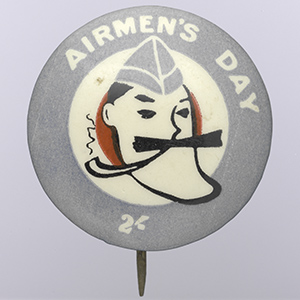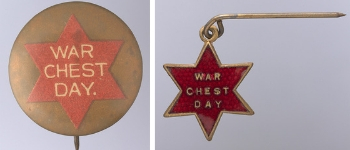To observe Remembrance Day on 11 November 2018, we are sharing an assortment of First and Second World War badges from the Father Leo Hayes Collection. These artefacts represent fundraising activities that occurred in Australia to support the war effort and are a reminder that conflict is not without cost.
On Remembrance Day we “observe one minute’s silence to remember those who died or suffered for Australia’s cause in all wars and armed conflicts.”
Origins of Remembrance Day, Australian War Memorial.
Australian Comforts Fund

1. Our fighting men, Australian Comforts Fund
2. ACF Australia
3. Comforts Fund Appeal Day.
The Australian Comforts Fund (ACF) was established in August 1916 and operated between 1916-1920 and 1940-1946. The ACF was first established from many State-based organisations and groups supporting the war effort.
Unlike the Red Cross, who cared for sick and wounded troops, the ACF provided for the fit and well.
ACF volunteers, mainly women, would fundraise through various activities including selling badges and homemade goods. The funds raised through these activities helped provide comforts to the troops like clothing, tobacco, cakes, condensed milk, and newspapers.
The ACF distributed Embarkation Kits, which were given to every member of the armed forces as they left for active duty. They also ran small canteens near the front lines and ran recreational clubs for troops when on leave in London.
Many different designs of buttons and badges were produced for the ACF including stickpin and button styled badges.
“Roger that”

The "Royal Australian Air Force Memorial Centre" appeal badge or "Airmen’s Day" badge, features a character pilot, depicted with a bristling moustache, a pipe and wearing a field service cap.
The character was called “Roger” after the radio communication that indicates that a message has been received and understood while flying a plane. Saying “Roger” was used widely in the Royal Australian Air Force (RAAF) not only officially on the job, but also as a slang expression of approval.
The badge was sold and distributed during the appeal on Airmen's day 27 June 1947.
War Chest Day

War Chest was a fundraising group from New South Wales affiliated with the ACF. Their main purpose was to raise funds through the sale of buttons or badges. The proceeds went to ACF to distribute comfort items to Aussie troops.
War Chest Day was held three times during the First World War, on 30 June 1916, 28 September 1917 and 29 November 1918 and the price of the badges ranged from one shilling to one pound.
Why the Library has items like this
Items like these badges are part of our cultural heritage. They were donated to the Fryer Library and were digitised so they could be preserved and shared.
Visit UQ eSpace to explore more of these fascinating items.
Tell us what you think
Did you find this story interesting? Let us know on Facebook or Twitter.
References
- Annie Stevens. (n.d.). 'Patriotic fundraising', Sydney Living Museum. Retrieved from https://sydneylivingmuseums.com.au/ww1/patriotic-fundraising,
- Australian War Memorial. (n.d.). Guide to the Australian Comforts Fund Souvenir Collection. Retrieved from https://www.awm.gov.au/collection/accessing-records-at-the-memorial/findingaids/special/souvenirs/comfortsfund
- Australian War Memorial. (n.d.). Remembrance Day. Retrieved from https://www.awm.gov.au/index.php/commemoration/remembrance-day
- Australian Women's Register. (2017). Australian Comfort Fund (1916 - 1920). Retrieved from http://www.womenaustralia.info/biogs/AWE0988b.htm
- C.O. Badham Jackson. (1949). Proud Story: The official history of the Australian Comforts Fund. Sydney: Johnston.
- Memorial button shows "Roger" (1947, May 29). The Sydney Morning Herald, p. 5. Retrieved from http://nla.gov.au/nla.news-article18028358
This story is part of our 2018-2019 Summer Series of blog posts. The posts are full of interesting stories and images from our cultural and heritage collections. We encourage you, dear reader, to indulge.